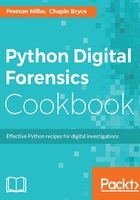
Introduction
Digital forensics involves the identification and analysis of digital media to assist in legal, business, and other types of investigations. Oftentimes, results stemming from our analysis have a major impact on the direction of an investigation. With Moore’s law more or less holding true, the amount of data we are expected to review is steadily growing. Given this, it’s a foregone conclusion that an investigator must rely on some level of automation to effectively review evidence. Automation, much like a theory, must be thoroughly vetted and validated so as not to allow for falsely drawn conclusions. Unfortunately, investigators may use a tool to automate some process but not fully understand the tool, the underlying forensic artifact, or the output’s significance. This is where Python comes into play.
In Python Digital Forensics Cookbook, we develop and detail recipes covering a number of typical scenarios. The purpose is to not only demonstrate Python features and libraries for those learning the language but to also illustrate one of its great benefits: namely, a forced basic understanding of the artifact. Without this understanding, it is impossible to develop the code in the first place, thereby forcing you to understand the artifact at a deeper level. Add to that the relative ease of Python and the obvious benefits of automation, and it is easy to see why this language has been adapted so readily by the community.
One method of ensuring that investigators understand the product of our scripts is to provide meaningful documentation and explanation of the code. Hence the purpose of this book. The recipes demonstrated throughout show how to configure argument parsing that is both easy to develop and simple for the user to understand. To add to the script's documentation, we will cover techniques to effectively log the process that was taken and any errors encountered by the script.
Another unique feature of scripts designed for digital forensics is the interaction with files and their associated metadata. Forensic scripts and applications require the accurate retrieval and preservation of file attributes, including dates, permissions, and file hashes. This chapter will cover methods to extract and present this data to the examiner.
Interaction with the operating system and files found on attached volumes are at the core of any script designed for use in digital forensics. During analysis, we need to access and parse files with a wide variety of structures and formats. For this reason, it's important to accurately and properly handle and interact with files. The recipes presented in this chapter cover common libraries and techniques that will continue to be used throughout the book:
- Parsing command-line arguments
- Recursively iterating over files and folders
- Recording and preserving file and folder metadata
- Generating hash values of files and other content
- Monitoring code with progress bars
- Logging recipe execution information and errors
- Improving performance with multiprocessing